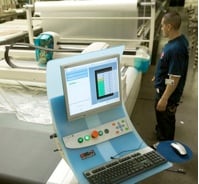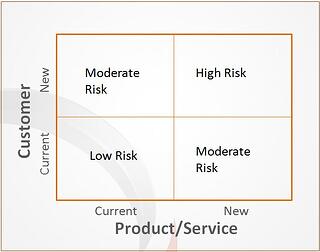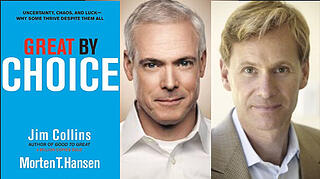Growth Insights for CEOs
Pete Hayes
/CMO-Pete-Hayes.jpg?width=320&name=CMO-Pete-Hayes.jpg)
Recent Posts

Outsider Insights | From Hustle to System: Why More CEOs Are Rebuilding Their Sales Function
Outsider Insights
Across Chief Outsiders, we talk to hundreds of CEOs every month. In this new series, we explore the trends and challenges we’re hearing from these discussions – and what you can do if you’re facing the same issues in your business.
Recent Posts

Successful Family Business: 2nd Generation Growth Spurt
Sun, Mar 17, 2013 — We were in Dallas, attending the Vistage International Conference. The ballroom was packed with 1,100 CEOs and Vistage Chairs from across the country and around the world. It’s exciting to be around successful business leaders, anticipating that with your next handshake you’ll meet someone whose story will be one you can’t forget. That’s when I met Dan Mollura, a second-generation leader of a family business, Vinyl Technology, from Southern California. They design and manufacture an array of vinyl and plastic products for customers including the Army, Air Force, Defense Department, and NASA. He’d realized over 300% growth ($8M to over $30M) in the 7 years since taking over from his father. That’s amazing. But that’s not what got my attention. He said the reason for his success was that he was more conservative, more analytical, than his entrepreneurial Dad. Wow. I had to learn more. Breaking Up Before Breaking Out Dad was an immigrant from Argentina. He had been a pioneer in the waterbed business until the industry softened; then he’d started Vinyl Tech. With several sons, Dad had his eyes on Dan and began grooming him as his potential successor. But Dad was not ready to let go, and a falling-out resulted in Dan quitting, leaving the family business to pursue real estate. Eventually, Dad recognized he needed Dan back in the business and approached the brothers to ask Dan to come back. And he did. This act of rebellion and reconciliation was clearly the moment of truth for their successful transition. It took Dad two more years to fully let go, but the process was underway, and the ground rules understood.

Small Business Thrashing: When Nimble Makes You Numb
Thu, Nov 15, 2012 — Opportunities Galore… This small company is 15 years old, and has a few million in sales. The founder has returned from semi-retirement to help lead and reinvigorate the team. In the past year or so, the firm introduced a number of innovative new services, including its first consumer-direct offering. It has also partnered with several adjacent industry players and is leading the effort to capture yet another clear opportunity. The small staff works tirelessly to support every new initiative while keeping the wheels on its core offering that delivers 85% of its revenue. While sales overall are not expanding and no one has received a pay increase in years, there are no complaints. These are good people. And they know the power of working nimbly and collaboratively. …But Hungering For Growth Like many of businesses of their size and age, this company hungers for faster, more predictable growth. They are tired of being small when they are part of a market that seems so promising. During our first meeting, it was immediately clear that the company leadership consists of a sharp group of professionals. In our exploratory work session (90 minute complimentary consultation) everyone engaged, all contributing, respectfully listening to new ideas, and adding value to our conversation.

The 3 Distinct Advantages of Vistage
Sat, Sep 15, 2012 — Leaders of mid-sized companies are pretty impressive people. As leaders, they bring insight, determination and courage to work every day. So where do the great CEOs of these companies go to get better? Some 16,000 mid-market leaders worldwide have figured a way to get expert advice – from each other. As a Vistage member, a roomful of CEOs during any given monthly meeting may be directing their focus on your business. Over time, they’ve gotten to know how you tick. And they’re providing insights; offering their experience; even holding you accountable from one meeting to the next. That’s the core value that Vistage brings its members. Chair Leadership The concept of CEO peer groups isn’t unique. But it’s highly effective. And Vistage has honed the practice to an art. By recruiting top business leaders still in their prime into the role of Chairs, then assembling “boards” of CEOs of similarly sized non-competitive companies, Vistage orchestrates an environment that is unmatched by any other CEO peer group organization that we’ve encountered at Chief Outsiders. Patrick “Pat” Mulligan of Austin knows the value of Vistage inside and out. As a young CEO, he joined Vistage in 1987 and learned firsthand how a peer group of business leaders could improve performance. Now, Pat is putting his decades of experience to use as one of the founding Chairs in Austin, and leader of 3 peer groups. There are several dynamics in his peer groups that work together to ensure value for his members:
Stay up-to-date with the latest from Chief Outsiders

9 Disciplines to Activate Collins’ 20-Mile March
Wed, Jul 25, 2012 — Discipline is Good, Right? In Jim Collins’ “Great By Choice” this pyramid model provides a framework for his trilogy-logical discussion. I’ve read this book wearing two lenses – one, as a principal in our firm, and two as a marketing executive. As a business leader, I aspire to a higher level of discipline in my leadership as well within my personal work ethic. As a marketer, I recognize – primarily from the past 10 years of expanding digitally-dominated marketing and dynamic market ecosystems – that discipline is indeed the capstone of success. Goes Against My Instincts The 20 Mile March is “Jim Collins code” for consistent, methodical and metered execution. He correctly calls it out as a choice or decision, even a strategy, for securing sustained growth. The argument goes against several mantras ingrained within me – “strike while the iron’s hot” “leverage your opportunities” “capture the moment”. No, instead, his research observed that companies win (and south pole explorers survive) when they meter their progress. How might this apply to our business at Chief Outsiders? Perhaps we should add one new major market a year to our firm, regardless of the market conditions. If it’s a tough year, we add one new market. If the economy is rocking and highly favorable, we still add only one new market. Collins’ research tells us the benefits of steady pace outweigh the opportunistic instinct to lunge ahead in good times or hunker down in tough times.

Jim Collins' Great By Choice: SMaC Develops Your "Brand"
Tue, Jul 17, 2012 — What we can learn from Jim Collins' Great By Choice I’m a huge Jim Collins fan (and look forward to seeing him at the Global Leadership Summit Aug 9/10). But I will admit that I haven’t read all of his books cover to cover. You know, you pull a few cool ideas then lose interest once the nuggets have been revealed. That was until Jim Collins' “Great By Choice." I couldn’t put this one down and I couldn’t get enough. Perhaps it’s having the perspective from his prior findings, models and perspectives to build upon. But I found “Great By Choice” to be Jim’s best and most practical piece yet. In summary, I found that this wonderful book shares simple, actionable truths applicable to businesses of all sizes. Use SMaC to Develop Your Brand - Practices Can Last Decades Like many, I use a Kindle and enjoy highlighting and making notes as I go. Then I go back and review the “greatest hits” to be sure I’m activating the concepts I had hoped to retain. Having just done that, I was again taken by the SMaC (Specific, Methodical and Consistent) model and approach with this summary: “A solid SMaC recipe is the operating code for turning strategic concepts into reality, a set of practices more enduring than mere tactics. Tactics change from situation to situation, whereas SMaC practices can last for decades and apply across a wide range of circumstances.” - Jim Collins' “Great By Choice” Chapter 6 Struck by the phrase “practices can last for decades,” because it’s perhaps an unspoken truth that the 10X (winning) companies build their reputations (their brands) by executing consistently, over time. Collins’ references to company recipes and even the U.S. Constitution Articles that don’t change from year to year, but may evolve with highly considered amendments, is a reminder of knowing what you stand for. In our firm, we find this so important we’ve made it a centerpiece of our approach with clients, specifically our Purpose-Driven Marketing. With a business’ purpose in place – a purpose that reflects their knowledge of the marketplace – one can make plans, decisions and take actions with a consistency that other companies can’t.

#1 Way to Innovate: Execute
Thu, Jul 5, 2012 — As business leaders, we’re seduced into believing that innovation is the key to competitive advantage. How could anyone argue that an industry-changing product wouldn’t be a company’s ticket to leadership and success? Well, Jim Collins and Morten Hansen make a compelling and empirically-grounded counter argument in “Great By Choice”. Their 10X companies (those with substantially greater long term performance) are actually less innovative than their more innovative but less successful counterparts. Ultimately, it’s the company that “innovates” incrementally that is better prepared (and productively paranoid) that wins the day. The Cambridge Group has written fairly extensively on innovation. In their book “How Companies Win” Kash and Calhoun start with a compelling definition: “Innovation is finding unsatisfied profitable demand, then fulfilling it.” They go on to describe dimensions of Total Innovation: Invention New Product Innovation Product Enhancement Innovation Commercial (non-product) Innovation Operational Innovation Business Model Innovation

CEOs: Getting Business "From Here to There"
Sun, Sep 12, 2010 — I spent part of last month enjoying and being "filled" at the Willow Creek Global Leadership Summit. One of my favorite concepts was something so simple and yet so rich that I can't stop thinking about it: the idea that leadership is all about getting from HERE to THERE. Bill Hybels tee'd up the notion. And then soon after, Jim Collins built upon it in his "How the Mighty Fall" discussion.
.png?width=1500&height=398&name=CO_Corporate%20Logo%202021_4C_HOR_FNL-1%20(1).png)